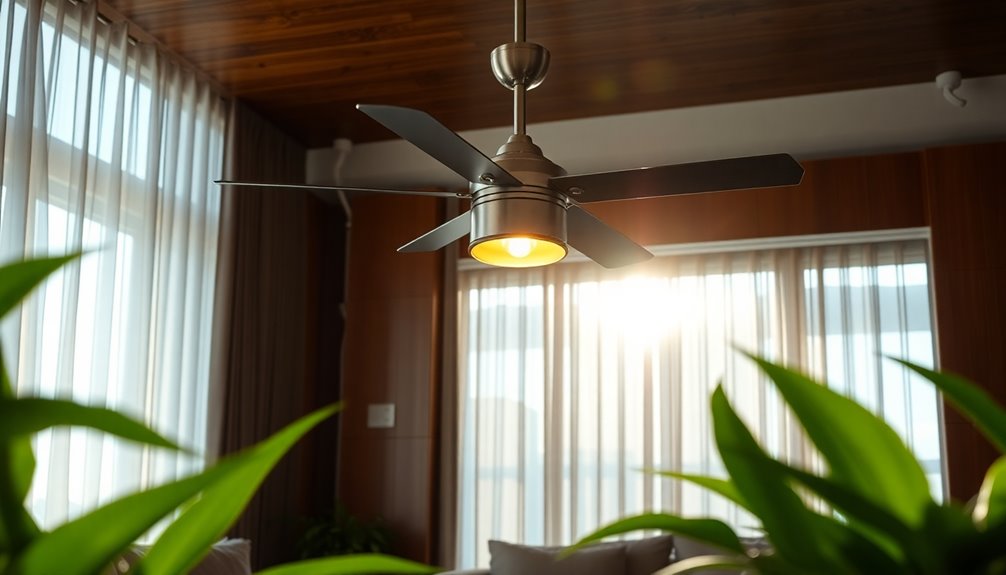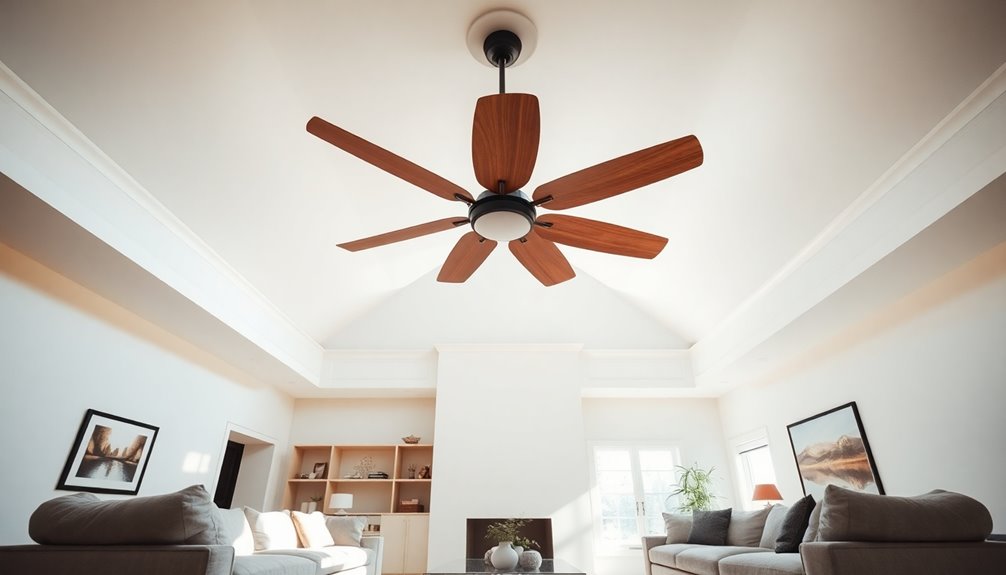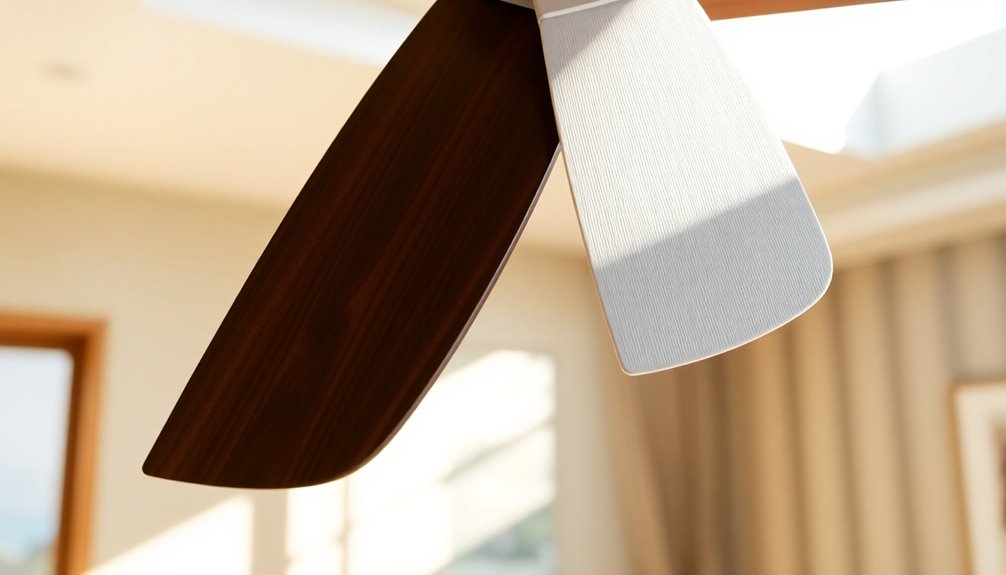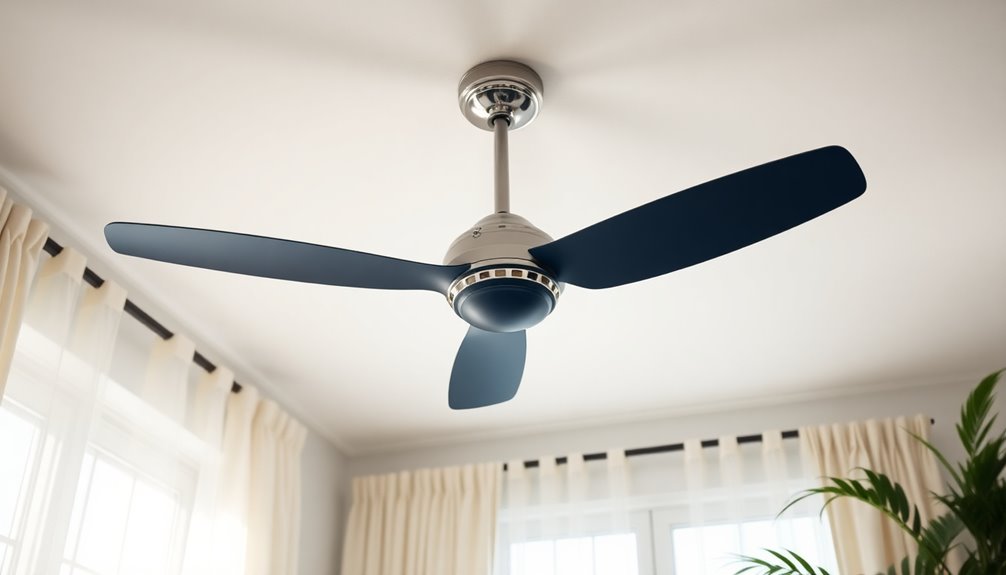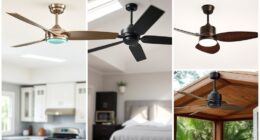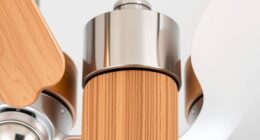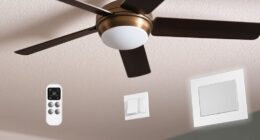You can't use a standard dimmer switch on a ceiling fan due to safety concerns. Dimmer switches adjust voltage, while fan controllers manage amperage. Using a dimmer can lead to overheating, buzzing noises, and even fire hazards. Instead, opt for a fan speed controller that's designed specifically for ceiling fans. If you want to control the fan and lights independently, consider smart dimmers or split dimmers, ensuring they're compatible with your fan model. Understanding the right setup is essential for safe operation, and there's more to discover about ensuring your fan functions properly and safely.
Key Takeaways
- Standard dimmer switches can damage ceiling fan motors and reduce lifespan; use fan-specific speed controllers instead.
- Overheating and fire hazards can arise from using dimmer switches on ceiling fans.
- For independent control of fan and light, separate wiring and compatible controls are necessary.
- Always verify that the dimmer is rated for the total wattage of your light fixtures.
- Consulting a licensed electrician ensures safe installation and compliance with local electrical codes.
Safety Concerns

When considering how to control your ceiling fan's speed, have you thought about the safety implications of using a dimmer switch? While it might seem convenient, using a dimmer switch with your ceiling fan can lead to significant safety concerns.
Unlike fan controllers, which regulate amperage, dimmer switches adjust voltage. This difference is vital because regulating voltage can create overheating and fire hazards, putting your home at risk.
Additionally, using a dimmer switch can cause short circuits, increased buzzing noise, and reduced functionality in your ceiling fan. If you notice slower fan speeds accompanied by buzzing, it's a clear indicator of potential operational issues.
These problems not only hinder performance but also pose a risk to your safety. To avoid these dangers, it's important to prioritize safety by using proper fan controllers designed specifically for ceiling fans.
They guarantee safe operation and eliminate the fire hazards associated with dimmer switches. So, before making your choice, consider the long-term implications on your safety and the well-being of your home.
Choose wisely, and keep your ceiling fan running safely and effectively!
Cost of Installation

When it comes to installing a dimmer switch for your ceiling fan, you need to take into account both the switch's price and the electrician's fees.
Dimmer switches typically range from $10 to $50, but hiring a licensed electrician can add another $100 to $200 to your total cost.
Plus, if your home's existing wiring isn't up to code, you might face additional expenses for necessary upgrades.
Installation Expense Overview
Installing a dimmer switch for your ceiling fan can vary considerably in cost, especially if you factor in the price of the switch itself and professional installation fees. Generally, a dimmer switch costs between $10 and $50, depending on the brand and features.
However, hiring a licensed electrician for installation typically incurs charges between $100 and $200. If your existing wiring doesn't support the new dimmer switch, you might face additional expenses.
Here are some key points to take into account regarding installation expenses:
- Dimmer switch cost: $10 to $50
- Electrician fees: $100 to $200 for installation
- Potential wiring upgrades: Additional costs if existing wiring is inadequate
- Safety concerns: Always hire a licensed electrician to prevent hazards
- Long-term savings: Energy-efficient dimmer switches can reduce electricity bills over time
While the initial installation expense may seem high, the benefits of improved functionality and energy savings make it a worthwhile investment.
Prioritizing safety and hiring a professional guarantees your dimmer switch works correctly, providing peace of mind.
Electrician Charges Explained
Understanding electrician charges is vital for budgeting your ceiling fan dimmer switch installation. The average cost for dimmer switches varies between $10 and $50, depending on the brand and features you choose. Meanwhile, electricians typically charge between $100 and $200 for installation. This cost can fluctuate based on local rates and the complexity of your job.
If your existing wiring isn't up to par, you might face additional costs for necessary upgrades. Hiring a licensed electrician is essential to guarantee safe and compliant installation. This choice not only assures proper function but also helps you avoid future issues and expenses.
Here's a breakdown of potential costs:
| Cost Component | Estimated Amount |
|---|---|
| Dimmer Switch | $10 – $50 |
| Electrician Labor | $100 – $200 |
| Additional Wiring Upgrades | Variable |
Switching out dimmer switches can be a cost-effective upgrade, allowing you to control fan speed and enhance your home's lighting without major renovations. By being informed about these costs, you can make a smarter decision for your installation.
Maintenance Recommendations

To maintain safety and functionality, you should regularly inspect your dimmer switches for signs of overheating, as hot switches can indicate an overload that poses a fire risk.
Proper maintenance is essential to guarantee your light fixture operates safely, especially when using dimmer switches with ceiling fans.
Here are some key maintenance recommendations:
- Check for any signs of wear or damage on the dimmer switches.
- Confirm metal boxes containing dimmer switches are properly grounded to prevent electrocution hazards.
- Inspect two-prong outlets for grounding issues, as these may indicate ungrounded systems needing upgrades.
- Shift to three-prong outlets for improved safety and compliance with insurance requirements.
- Conduct routine assessments of all electrical components to identify potential risks before they escalate.
Professional Assistance

When it comes to electrical work involving ceiling fans and dimmer switches, seeking a licensed electrician's expertise is crucial for guaranteeing safety and compliance with local codes. These professionals have the knowledge needed to assess your existing wiring and determine its suitability for new dimmer switch installations. This is essential to prevent potential hazards that could arise from improper installations.
Before replacing any switches, it's a good idea to check the types of outlets available in your home. If your system is ungrounded, you might need upgrades for safety. Local home inspection teams can provide referrals to reputable electricians who can conduct thorough evaluations of your electrical setup.
Here's a quick comparison of potential benefits of hiring professional assistance versus DIY:
| Professional Assistance | DIY Approach | Risks |
|---|---|---|
| Safety Compliance | Cost Savings | Potential Hazards |
| Expert Evaluation | Limited Knowledge | Code Violations |
| Warranty Protection | No Guarantees | Fire Risks |
In short, involving licensed electricians guarantees your ceiling fan and dimmer switch installation is safe and up to standard.
Dimmer Switch Requirements

Ceiling fan enthusiasts should be aware that standard dimmer switches aren't suitable for controlling fan operations. These switches regulate voltage rather than the necessary amperage for fan motors, which can lead to a host of issues.
Using a regular dimmer switch on a ceiling fan can cause overheating, humming noises, and even pose fire hazards due to improper electrical configurations.
To guarantee safe and effective operation, consider the following dimmer switch requirements:
- Use fan speed controllers specifically designed for ceiling fans.
- Choose split dimmers or smart dimmers that allow independent control of fan speed and light brightness.
- Confirm any dimmer or fan controller is rated for the total wattage of your light fixtures.
- Verify that the dimmer is compatible with your specific ceiling fan model.
- Avoid using standard dimmer switches with fans with light fixtures to prevent damage.
Ceiling Fan Compatibility

How do you guarantee your ceiling fan works efficiently with the right controls? The key lies in understanding compatibility.
Standard dimmer switches aren't suitable for ceiling fans because they regulate voltage, not the necessary amperage for fan motors. Using a regular dimmer can lead to overheating, reduced performance, and even fire hazards.
If your fan has integrated dimming features, you can use a compatible dimmer switch designed specifically for ceiling fans. This guarantees you have the right control over both the fan and the light.
When selecting a replacement switch, look for options that allow for independent control of the fan and light, which often requires separate wiring.
Misusing standard dimmers can severely impact your fan's motor performance and lifespan, so it's essential to assess compatibility before installation.
Always check the specifications to guarantee you're using the correct type of dimmer that matches your fan's requirements.
Common Installation Mistakes

Many homeowners make common installation mistakes that can compromise the performance of their ceiling fans. When you're looking to control a ceiling fan with a dimmer switch, it's essential to avoid these pitfalls:
- Using standard dimmer switches: These can lead to overheating and humming noises, damaging the fan motor. Regular maintenance of the fan can help prevent these issues.
- Not checking compatibility: Failing to verify if the fan is compatible with the control system can result in inadequate performance, much like how air purifiers improve indoor air quality effectively.
- Neglecting separate circuits: Not running separate circuits for the fan and light can restrict their independent operation.
- Ignoring wattage ratings: Overloading beyond the wattage ratings for the fan and light fixtures can cause equipment failure and safety hazards.
- Overlooking neutral wires: If you're adding a dimmer switch, confirm you have the required neutral wires to avoid installation failures, especially with smart switches.
To successfully install a ceiling fan with a dimmer switch, double-check these factors. Furthermore, understanding the refrigeration cycle of heat pump systems can enhance your knowledge of electrical components in various home installations.
Frequently Asked Questions
Is It Okay to Have a Ceiling Fan on a Dimmer Switch?
It's not advisable to use a standard dimmer switch with your ceiling fan.
Doing so can lead to overheating, humming noises, and even damage to the fan.
Instead, opt for a specialized fan speed controller that's designed for ceiling fans.
This way, you can safely adjust the fan's speed without risking performance issues.
Always check compatibility with your fan model to guarantee proper operation and avoid potential hazards.
Can You Make Any Ceiling Fan Dimmable?
You might be dreaming of a soft, ambient glow from your ceiling fan, but not every fan can make that dream a reality.
To turn your fan into a dimmable delight, it needs to be equipped with specific features and compatible components. If it's got the right wiring and a built-in LED light kit, you're in luck!
Just make sure you have the right controls, and you'll create that enchanting atmosphere you desire.
Can a Light Dimmer Be Used as a Speed Control for a Ceiling Fan or Other Motor?
You can't use a light dimmer as a speed control for a ceiling fan or other motors.
Dimmer switches regulate voltage, but fans need specific controls to manage their motor's amperage effectively.
Using a dimmer can cause overheating, strange noises, and even fire risks.
Instead, opt for dedicated fan speed controllers or smart switches designed for ceiling fans to guarantee safe and efficient operation while extending the lifespan of your fan.
What Is the Difference Between a Fan Control and a Dimmer?
A fan control and a dimmer switch serve different purposes.
While a dimmer adjusts voltage to change light brightness, a fan control manages amperage to alter fan speed.
You can't interchange them without risks; using a dimmer on a fan can cause overheating and damage.
Fan controls are specifically designed for safe operation, ensuring your ceiling fan runs effectively.
Conclusion
In summary, using a dimmer switch on your ceiling fan can enhance your comfort and style, but it's essential to guarantee compatibility and safety first. Think of your fan as a dance partner—both need to move in harmony. Remember to consult a professional if you're unsure, and always follow installation guidelines to avoid common pitfalls. With the right approach, you can create the perfect ambiance for any occasion!
